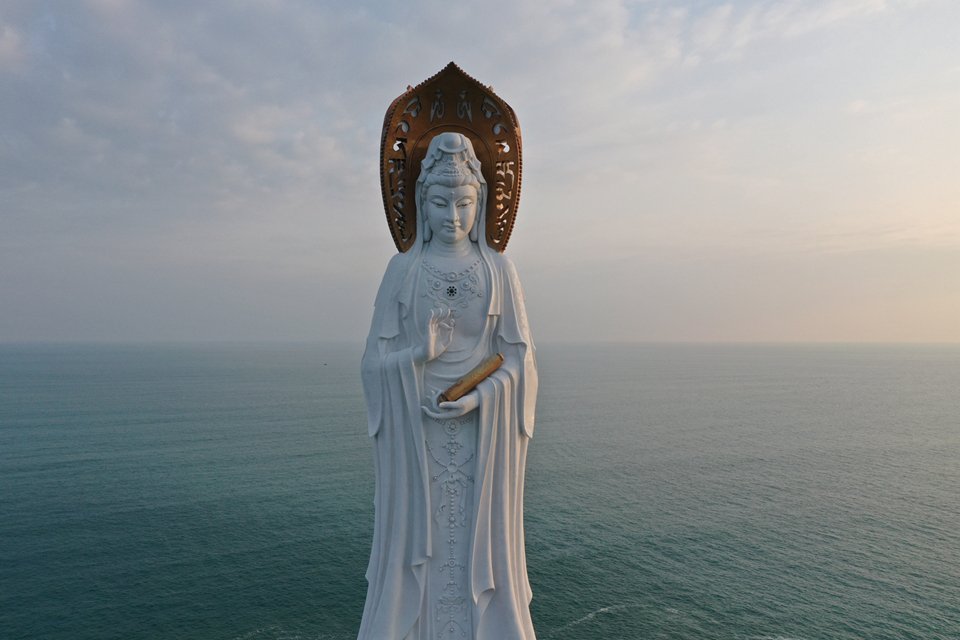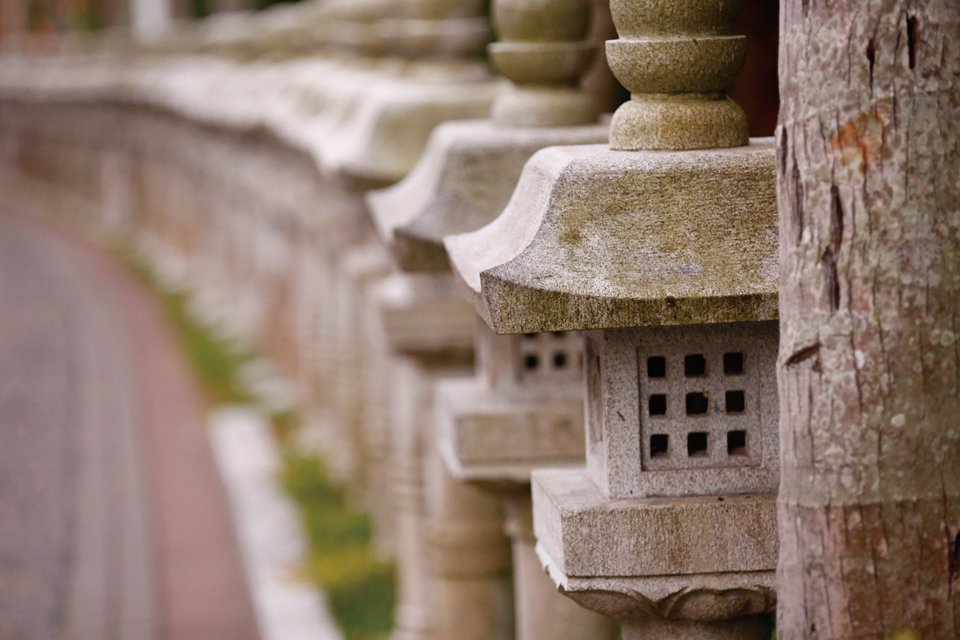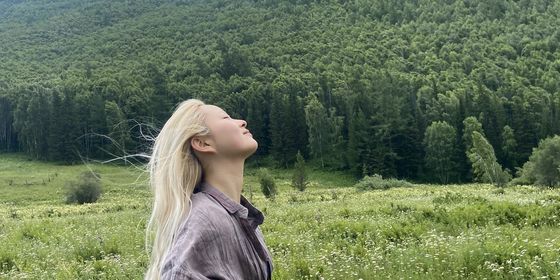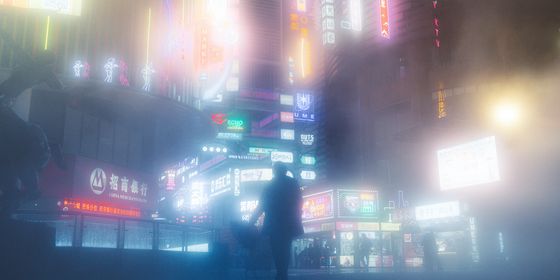Buddhism and Daoism have deep roots in China's southernmost province Hainan.
The glittering nightlife and upscale resorts of Haitang Bay and Yalong Bay may seem like temples to everything materialistic and profane, but Hainan’s religious past shines through plenty of natural and cultural destinations on the island. Centuries of Buddhist and Daoist influence have left traces in statues, shrines, and even rock formations that serve as settings for fantastical fables about immortals and deities, blurring the lines of religion and mythology.
BUDDHISM
Nanshan Cultural Tourism Area
A soaring statue of Guanyin (观音), taller than the Statue of Liberty in New York, rises 108 meters above the waves of the South China Sea. At dusk, the white-robed goddess of mercy is tinted purple against the setting sun, and her golden halo and lotus pedestal glint with gold. Standing at the base of its gleaming presence, visitors are filled with serenity and compassion as wide as the ocean that the statue faces.
Known as the “Guanyin on the Southern Sea,” the goddess, who is based on the (male) bodhisattva Avelokitesvara, is sculpted with three heads and bodies: one body facing back toward Sanya, and the other two gazing out toward the endless blue. Approached from the pier, the front side facing the visitor holds a sutra, symbolizing wisdom; the right side holds prayer beads, symbolizing compassion; and the left side holds a lotus flower, symbolizing peace. The crown jewel of the Nanshan Cultural Tourism Area (南山文化旅游区) near Sanya, the Guanyin became the eighth tallest statue in the world upon its completion in 2005, and is part of the biggest Buddhist-themed construction project since the founding of the People’s Republic of China.
Further along the coast, the grandiose Nanshan Temple (南山寺), built to commemorate the 2,000th anniversary of Buddhism’s arrival in China, was completed in 1998 on a cliff overlooking the sea. Constructed in the architectural style of Tang dynasty (618 – 907), the Nanshan Temple is an active monastery for Buddhist abbots and monks. As visitors share the stone steps and verdant gardens with the worshipers, an atmosphere of sacredness pervades the expanse of twisting banyan trees and incense-filled courtyards. Drawing devout Buddhists on pilgrimages, the temple offers multiple vegetarian restaurants and sitting rooms where visitors can copy scrolls of Buddhist sutras.
Statues of two warriors stand guard at the Renwang Gate (仁王门), marking the temple’s entrance. Inside the main halls are statues of Sakyamuni (释迦牟尼), Bhaisajyaguru (药师佛), and Amitabha (阿弥陀佛) Buddhas. However, the most impressive craftsmanship is once again saved for the bodhisattva of mercy—in the Hall of Thirty-Three Guanyins (三十三观音堂). Housing statues of the goddess’s 33 legendary incarnations, the exhibit took more than 130 craftsmen over four years to create, and displays masterful lacquer and gold-plating techniques.
The most elaborate, and almost ridiculously ostentatious treasure of Nanshan is the heavily bejeweled Golden Jade Guanyin. The 3.8-meter statue, which contains two sacred Buddhist relics, is plated with 100 kilograms of gold and silver, and topped off with 120 carats of South African diamonds, as well as tablets of red sapphires, emeralds, coral, turquoise, pearls, and jadeite.
The Nanshan Cultural Tourism Area is one of the largest initiatives attempting to propel Chinese Buddhism into the future. Surrounded by lush landscapes, framed by the roaring ocean, and with an impressive harmony of architecture and Buddhist artwork, Nanshan is the island’s premier destination for those seeking enlightenment—or at least a breathtaking sunset and some ocean air to temporarily abate life’s adversities.
DAOISM
Daxiao Dongtian Scenic Area
It’s said that the Queen Mother of the West once gave the Eight Immortals of Daoism a magic peach. However, a fairy cow ate half of it before the Immortals could get a bite, so they discarded the rest. After a few thousand years, the forgotten half-peach became a stone, which now sits on the rocky beach in southern Hainan alongside more banal boulders on the shoreline. The “Immortal Fairy Peach” is now one of 50 idiosyncratic attractions at Daxiao Dongtian Scenic Area (大小洞天风景区), along with “useless wood” and “dragon’s blood tree,” two indigenous tropical plants.
A common formal expression to wish someone well in Chinese is to bless them with “the prosperity of the East Sea, and the longevity of the Southern Mountain.” The southern mountain in question supposedly refers to Nanshan in Sanya, which has long been considered an auspicious location. Now open as a tourist site, the Daxiao Dongtian Scenic Area is a rugged seaside destination steeped heavily in Daoist lore.
One of the park’s most direct homages to Daoism is the stone sculpture “Laozi Watching the Sea.” Carved using the natural shape of a mountain cliff, the renowned founder of Daoism is portrayed leaning against the mountain, his deep-set eyes trained on the sky in eternal contemplation. Another famed Daoist figure, Bai Yuchan (白玉蟾), the founder of the Southern sect of Daoism, is said to have retired to Nanshan Mountain after attaining immortality. The place where he once sat to practice and refine his breathing has become known as the “Immortal Altar” to later generations.
As early as the Southern Song dynasty (1127 – 1279), the then-governor of Hainan, Mao Kui (毛奎), left inscriptions on stones and cliffsides describing a large and a small heavenly grotto, or dongtian, the namesakes of the scenic area. In Daoist lore, there are 10 large and 36 small heavenly grottoes, where sages live in seclusion and strive for immortality. While the whereabouts of the large dongtian remains a mystery today, the park is home to a small heavenly grotto—a wide, low crevice in the stone, through which non-claustrophobic visitors can walk. It is said that Mao Kui ascended to heaven here—maybe you can, too.
Wenbi Peak Pangu Cultural Tourism Area
Yet another fun origin story involving negligent immortals: A Daoist immortal was preparing baskets of enchanted soil to deliver to the Queen Mother of the West for use in her enchanted peach garden (celestial beings have yard work too, apparently). However, on the immortal’s way, he passed by Ding’an county in Hainan, where he was so struck by the beauty of the landscape that he stopped for a rest, became drunk on wine, and slumbered for so long that the baskets of enchanted earth became mountains. Thus, Wenbi Peak (文笔峰) was formed.
Vestigial evidence of the immortal’s failed delivery is scattered all over Wenbi Peak, which features attractions called the “Immortal’s Cave,” “Immortal’s Footprint,” “Immortal’s Palm,” “Immortal’s Wine Glass,” and even “Fairy’s Room.” Where did the “Fairy’s Room” come from, you ask? Well, while the Queen Mother of the West was growing impatient waiting for her enchanted soil, she sent a fairy down to check on the delivery. No matter how much the fairy tried, she could not wake the immortal from his drunken stupor. Helpless, she too grew drowsy and took a nap. When she woke up, it was already time to return to heaven, albeit empty-handed. However, she left behind a stone bed in a cave, now known as the “Fairy’s Room.”
Based on the style of the Southern Song dynasty, the tourist area holds the world’s largest complex of Daoist architecture. The Yuchan Palace (玉蟾宫), named after Bai Yuchan, includes an octagonal pavilion and numerous temples devoted to Daoist deities: the seafearers’ goddess Mazu (妈祖), the mystical Ming dynasty (1368 – 1644) medic Li Shizhen (李时珍), a god of wealth, and numerous ancestors of the Southern sect. The Yuchan Palace also has an active martial arts team, now home to ninth generation heirs of the “Southern Fist” technique, who represent the temple in international martial arts competitions.
Cover image: The giant Guanyin statue in Sanya, built in 2005; All photographs by Zhong Ming
Excerpt taken from Hainan: Jade Cliffs to Ocean Paradise, TWOC’s new guide to China’s southernmost province. Get your copy today from our WeChat store!
















